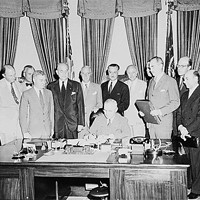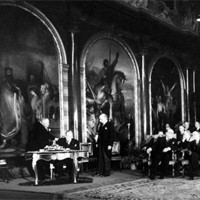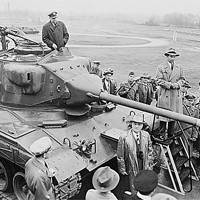NATO, the North Atlantic Treaty Organization, stands as a cornerstone of global security. Why Was Nato Formed? This article, brought to you by WHY.EDU.VN, delves into the historical context, strategic objectives, and enduring relevance of NATO, exploring its creation as a bulwark against Soviet expansionism and its evolution into a vital alliance for addressing contemporary security challenges. Explore the reasons behind its establishment, its initial goals, and its ongoing significance in maintaining international stability with insights available at WHY.EDU.VN.
1. The Genesis of NATO: Post-World War II Europe
The seeds of NATO were sown in the aftermath of World War II, a period marked by widespread devastation and profound geopolitical shifts. The war had left Europe in ruins, both economically and politically, creating a power vacuum that the Soviet Union was eager to fill.
1.1. The Threat of Soviet Expansionism
The Soviet Union, under the leadership of Joseph Stalin, emerged from World War II as a dominant force in Eastern Europe. The Red Army occupied much of the region, and Stalin installed communist regimes in countries such as Poland, Hungary, and Czechoslovakia. This expansionist behavior raised alarm bells in Western Europe and the United States.
1.2. Economic Instability and the Marshall Plan
Europe’s economic woes further exacerbated the situation. The war had crippled industries, destroyed infrastructure, and left millions of people impoverished. Recognizing the link between economic stability and political security, the United States launched the Marshall Plan in 1948. This massive economic aid program helped rebuild Western Europe and prevent the spread of communism by addressing the root causes of social unrest. However, the Soviet Union forbade its satellite states from participating, deepening the divide between East and West.
2. The Berlin Blockade: A Catalyst for Collective Security
The Berlin Blockade of 1948-1949 proved to be a pivotal moment in the formation of NATO. Stalin’s attempt to cut off West Berlin, which was jointly controlled by the United States, Britain, and France, demonstrated the Soviet Union’s willingness to use aggressive tactics to achieve its goals.
2.1. The Western Response: The Berlin Airlift
The Western Allies responded to the blockade with the Berlin Airlift, a remarkable feat of logistics that kept West Berlin supplied with food, fuel, and other essential goods. The airlift demonstrated the resolve of the Western powers to defend their interests and protect the people of West Berlin.
2.2. The Realization of Vulnerability
The Berlin Blockade also highlighted the vulnerability of Western Europe to Soviet aggression. Without a collective security arrangement, individual nations were ill-equipped to deter or defend against a potential Soviet attack.
3. The Brussels Treaty: A Precursor to NATO
In March 1948, Great Britain, France, Belgium, the Netherlands, and Luxembourg signed the Brussels Treaty, a collective defense agreement that pledged mutual assistance in the event of an attack. This treaty laid the groundwork for a broader alliance that would include the United States and Canada.
3.1. Limitations of the Brussels Treaty
While the Brussels Treaty was a significant step forward, it had limitations. The Western European nations lacked the military and economic resources to effectively counter the Soviet threat on their own. They needed the backing of the United States, the world’s strongest military power.
3.2. The Vandenberg Resolution
In May 1948, Republican Senator Arthur H. Vandenberg introduced a resolution in the U.S. Senate calling for the United States to seek a security treaty with Western Europe that would be consistent with the United Nations Charter but operate outside the Security Council, where the Soviet Union held veto power. The Vandenberg Resolution passed overwhelmingly, paving the way for U.S. participation in NATO.
4. The North Atlantic Treaty: Establishing Collective Defense
On April 4, 1949, the North Atlantic Treaty was signed in Washington, D.C., by the United States, Canada, and ten Western European nations: Belgium, Denmark, France, Iceland, Italy, Luxembourg, the Netherlands, Norway, Portugal, and the United Kingdom.
4.1. Article 5: The Cornerstone of NATO
Article 5 of the North Atlantic Treaty is the cornerstone of NATO’s collective defense commitment. It states that an attack against one member shall be considered an attack against all. This provision, known as the “one for all, all for one” principle, provides a powerful deterrent against aggression.
4.2. The Original Signatories
The original signatories of the North Atlantic Treaty represented a diverse group of nations with shared values and a common interest in deterring Soviet expansionism. Their commitment to collective defense laid the foundation for a lasting alliance.
5. The Strategic Objectives of NATO
NATO’s strategic objectives in the early years of the Cold War were primarily focused on deterring Soviet aggression and maintaining the balance of power in Europe.
5.1. Deterrence and Containment
NATO’s military strength and collective defense commitment served as a deterrent to Soviet aggression. The alliance aimed to contain the spread of communism and prevent the Soviet Union from expanding its influence beyond Eastern Europe.
5.2. Promoting Transatlantic Cooperation
NATO also played a crucial role in fostering cooperation and solidarity between North America and Europe. The alliance provided a framework for political and military consultation, strengthening the transatlantic relationship and promoting shared values.
6. The Korean War and NATO’s Transformation
The outbreak of the Korean War in 1950 had a profound impact on NATO, accelerating its transformation from a political alliance to a fully integrated military organization.
6.1. The Perception of Communist Aggression
The North Korean invasion of South Korea was widely seen in the West as an example of communist aggression directed by Moscow. This perception heightened fears of a similar attack in Europe and spurred NATO members to strengthen their defenses.
6.2. Integrated Military Command
In response to the Korean War, NATO established an integrated military command structure, with a Supreme Allied Commander Europe (SACEUR) responsible for the defense of the alliance’s territory. This move significantly enhanced NATO’s ability to respond to potential threats.
7. Expansion and Adaptation During the Cold War
Throughout the Cold War, NATO expanded its membership and adapted its strategy to meet evolving challenges.
7.1. New Members: Greece, Turkey, and West Germany
In 1952, Greece and Turkey joined NATO, extending the alliance’s reach to the Eastern Mediterranean. In 1955, West Germany was admitted, a move that the Soviet Union responded to by forming the Warsaw Pact, a rival military alliance.
7.2. The Doctrine of Flexible Response
In the 1960s, NATO adopted a new military doctrine known as “flexible response,” which replaced the earlier strategy of “massive retaliation.” Flexible response called for a more nuanced approach to deterrence, with a range of options available to respond to aggression, from conventional forces to nuclear weapons.
8. NATO After the Cold War: New Missions and Challenges
The collapse of the Soviet Union in 1991 marked the end of the Cold War and a profound shift in the global security landscape. NATO faced the challenge of redefining its role and purpose in a new era.
8.1. Peacekeeping and Crisis Management
In the post-Cold War era, NATO increasingly focused on peacekeeping and crisis management operations, often in cooperation with the United Nations. The alliance intervened in the Balkans in the 1990s to halt ethnic cleansing and promote stability.
8.2. Expanding Membership to Eastern Europe
NATO also expanded its membership to include former Soviet satellite states in Eastern Europe, such as Poland, Hungary, and the Czech Republic. This move was intended to consolidate democracy and stability in the region and prevent a resurgence of Russian influence.
9. NATO’s Intervention in Afghanistan
Following the September 11, 2001 terrorist attacks on the United States, NATO invoked Article 5 for the first time in its history, declaring that the attacks were an attack against all members. The alliance launched a military operation in Afghanistan to combat al-Qaeda and the Taliban.
9.1. The ISAF Mission
NATO’s mission in Afghanistan, known as the International Security Assistance Force (ISAF), lasted for more than a decade and involved troops from dozens of countries. The mission aimed to stabilize Afghanistan, train Afghan security forces, and prevent the country from becoming a safe haven for terrorists.
9.2. Challenges and Controversies
NATO’s intervention in Afghanistan faced numerous challenges, including a resilient insurgency, corruption, and a lack of effective governance. The mission also sparked controversy, with critics questioning its effectiveness and its impact on the Afghan people.
10. NATO’s Response to the Ukraine Crisis
In 2014, Russia annexed Crimea from Ukraine and began supporting separatists in eastern Ukraine. This act of aggression triggered a major crisis in relations between Russia and the West and prompted NATO to reassess its defense posture.
10.1. Strengthening Deterrence and Defense
NATO responded to the Ukraine crisis by strengthening its deterrence and defense capabilities, particularly in Eastern Europe. The alliance increased its military presence in the region, conducted more frequent exercises, and enhanced its readiness to respond to potential threats.
10.2. Supporting Ukraine
NATO also provided support to Ukraine, including training, equipment, and advice. The alliance has reaffirmed its commitment to Ukraine’s sovereignty and territorial integrity.
11. Contemporary Challenges Facing NATO
Today, NATO faces a range of complex and evolving challenges, including:
- Russian Aggression: Russia’s assertive foreign policy and military buildup pose a significant challenge to NATO’s security.
- Terrorism: The threat of terrorism remains a major concern for NATO members, requiring cooperation on intelligence sharing, border security, and counter-terrorism operations.
- Cyberattacks: Cyberattacks are an increasingly common form of aggression, and NATO must be prepared to defend itself against cyber threats.
- Hybrid Warfare: Hybrid warfare, which combines military, political, and economic tactics, poses a challenge to NATO’s ability to respond effectively to threats.
- Internal Divisions: Disagreements among NATO members on issues such as defense spending, burden-sharing, and relations with Russia can weaken the alliance’s unity and resolve.
12. The Future of NATO
Despite the challenges it faces, NATO remains a vital alliance for maintaining international security and promoting shared values. To remain relevant and effective in the future, NATO must:
- Adapt to New Threats: NATO must continue to adapt its strategy and capabilities to address new threats, such as cyberattacks and hybrid warfare.
- Strengthen Unity and Resolve: NATO members must work together to overcome internal divisions and maintain a united front against aggression.
- Enhance Cooperation with Partners: NATO should strengthen its partnerships with countries around the world that share its values and interests.
- Invest in Defense Capabilities: NATO members must invest in their defense capabilities to ensure that the alliance has the resources it needs to deter aggression and defend its territory.
- Uphold Democratic Values: NATO must remain committed to upholding democratic values and promoting human rights, both within its own ranks and around the world.
13. Expert Opinions on NATO’s Role
Numerous experts have weighed in on NATO’s significance and future trajectory. Here’s a brief overview:
| Expert | Affiliation | Quote |
|---|---|---|
| Ivo Daalder | Chicago Council on Global Affairs | “NATO remains the most successful alliance in history, but it must adapt to new threats and challenges.” |
| Julianne Smith | Council on Foreign Relations | “The key to NATO’s future is adapting to a more competitive and contested world.” |
| Jamie Shea | Friends of Europe | “NATO’s unique value lies in its ability to combine military strength with political consultation.” |
| Camille Grand | European Council on Foreign Relations | “For Europe, NATO remains the primary framework for transatlantic security cooperation.” |



14. Statistical Data on NATO
Understanding NATO’s impact requires considering key statistics. Here’s a look at some notable figures:
| Metric | Data | Source |
|---|---|---|
| Number of Member States | 32 | NATO Official Website |
| Combined Military Expenditure | Over $1 trillion USD | NATO Annual Reports |
| Personnel Strength | Approximately 3.5 million active military personnel | Various Defense Intelligence Agencies |
| Article 5 Invocations | 1 (following the 9/11 attacks) | NATO Archives |
| Major Operations | Afghanistan (ISAF), Balkans (KFOR), Libya (Operation Unified Protector) | NATO Fact Sheets |
15. Comparative Analysis of NATO and Other Alliances
Comparing NATO with other historical and contemporary alliances provides a clearer perspective on its unique characteristics:
| Feature | NATO | Warsaw Pact | ANZUS |
|---|---|---|---|
| Primary Objective | Collective defense against aggression | Counterbalance to NATO | Security in the Pacific region |
| Membership | North America and Europe | Soviet Union and Eastern Bloc states | Australia, New Zealand, United States |
| Duration | 1949 – Present | 1955 – 1991 | 1951 – Present |
| Key Characteristics | Integrated military command, democratic values | Soviet dominance, ideological alignment | Bilateral and trilateral security agreements |
16. Why Was NATO Formed? Addressing User Search Intent
To comprehensively address the question “Why was NATO formed?”, it’s crucial to align with various user search intents:
- Informational: Users seeking basic facts about NATO’s origins and purpose.
- Historical Context: Individuals researching the specific events and conditions that led to NATO’s creation.
- Strategic Analysis: Those interested in understanding NATO’s strategic objectives and how they have evolved.
- Current Relevance: People wanting to know how NATO addresses contemporary security challenges.
- Comparative Analysis: Users looking to compare NATO with other alliances and security organizations.
17. Call to Action: Explore More at WHY.EDU.VN
Do you have more questions about NATO or other complex topics? Are you seeking answers that are both detailed and easy to understand? Visit WHY.EDU.VN today. Our platform offers expert insights and explanations on a wide range of subjects, ensuring you get the knowledge you need.
At WHY.EDU.VN, we understand the challenges of finding accurate and reliable information. That’s why we’ve created a space where you can ask questions and receive answers from experts in various fields. Whether you’re a student, a professional, or simply curious about the world, WHY.EDU.VN is your go-to source for trustworthy information.
Contact us:
- Address: 101 Curiosity Lane, Answer Town, CA 90210, United States
- Whatsapp: +1 (213) 555-0101
- Website: why.edu.vn
18. FAQ: Understanding NATO’s Formation and Purpose
Here are some frequently asked questions about NATO, providing concise answers to common queries:
- What was the main reason for forming NATO?
- NATO was primarily formed to provide collective security against the threat of Soviet expansionism in post-World War II Europe.
- When was NATO officially established?
- NATO was officially established on April 4, 1949, with the signing of the North Atlantic Treaty.
- Who were the original member states of NATO?
- The original member states included the United States, Canada, Belgium, Denmark, France, Iceland, Italy, Luxembourg, the Netherlands, Norway, Portugal, and the United Kingdom.
- What is Article 5 of the North Atlantic Treaty?
- Article 5 is the cornerstone of NATO’s collective defense commitment, stating that an attack against one member shall be considered an attack against all.
- How did the Korean War impact NATO?
- The Korean War accelerated NATO’s transformation from a political alliance to a fully integrated military organization.
- What were NATO’s strategic objectives during the Cold War?
- NATO’s strategic objectives during the Cold War were primarily focused on deterring Soviet aggression and maintaining the balance of power in Europe.
- How has NATO adapted since the end of the Cold War?
- Since the end of the Cold War, NATO has focused on peacekeeping, crisis management, and expanding its membership to Eastern Europe.
- What is NATO’s role in addressing contemporary security challenges?
- NATO addresses contemporary security challenges such as Russian aggression, terrorism, cyberattacks, and hybrid warfare through deterrence, defense, and cooperation with partners.
- What are some of the key challenges facing NATO today?
- Key challenges include Russian aggression, terrorism, cyberattacks, hybrid warfare, and internal divisions among member states.
- What steps must NATO take to remain relevant and effective in the future?
- To remain relevant, NATO must adapt to new threats, strengthen unity and resolve, enhance cooperation with partners, invest in defense capabilities, and uphold democratic values.
By addressing these FAQs, we aim to provide a comprehensive understanding of NATO’s formation and its ongoing significance in the modern world.
